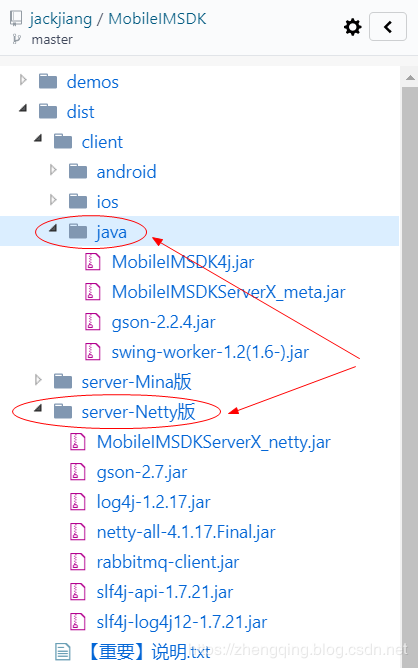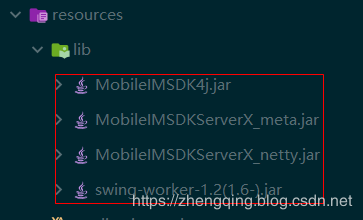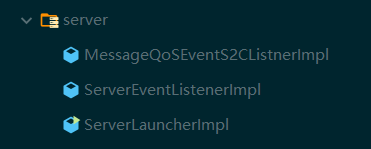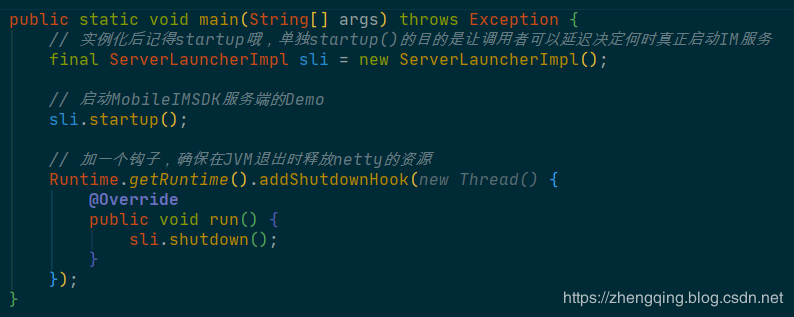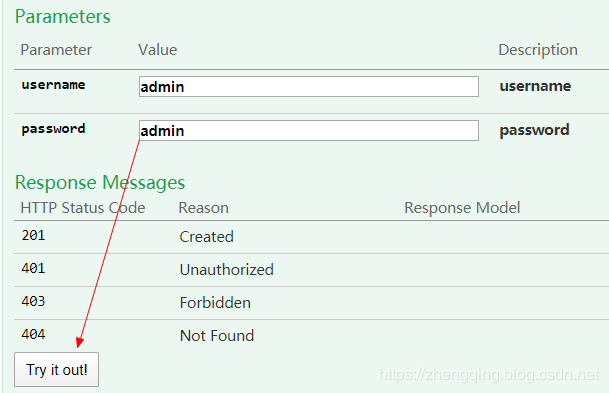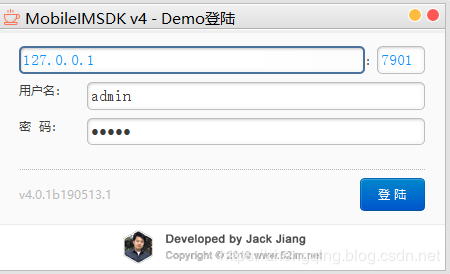一、前言
MobileIMSDK是什么?
一个专为移动端开发的开源原创即时通讯框架,超轻量级、高度提炼,完全基于UDP协议,支持iOS、Android、标准Java平台,服务端基于Mina和Netty编写。MobileIMSDK还可与姊妹工程 MobileIMSDK-Web无缝互通,从而实现Web网页端聊天或推送等。
本文将实现
- 基于
springboot2.1.8.RELEASE集成MobileIMSDK - 开发IM
服务端 - 开发
客户端 - 实现Java
客户端与客户端之间的通信
二、SpringBoot 集成 MobileIMSDK 准备
1、MobileIMSDK下载:https://gitee.com/jackjiang/MobileIMSDK
- 服务端所需jar包:
dist/server-xxx - 客服端所需jar包:
dist/client/java
2、pom.xml中引入相关依赖
由于这里是maven项目,其中一部分jar包可通过maven仓库直接引入,而其余的则通过外部jar包引入方式使用即可~
如下4个需作为外部jar包在pom.xml中引入
<!-- https://mvnrepository.com/artifact/com.google.code.gson/gson -->
<dependency>
<groupId>com.google.code.gson</groupId>
<artifactId>gson</artifactId>
<version>2.8.5</version>
</dependency>
<!-- MobileIMSDK所需jar包依赖[注:这里是在本地lib中引入,maven中央仓库中暂无此jar包],要与<includeSystemScope>true</includeSystemScope>配合使用-->
<dependency>
<groupId>com.zhengqing</groupId>
<artifactId>MobileIMSDK4j</artifactId>
<scope>system</scope>
<systemPath>${project.basedir}/src/main/resources/lib/MobileIMSDK4j.jar</systemPath>
</dependency>
<dependency>
<groupId>com.zhengqing</groupId>
<artifactId>MobileIMSDKServerX_meta</artifactId>
<scope>system</scope>
<systemPath>${project.basedir}/src/main/resources/lib/MobileIMSDKServerX_meta.jar</systemPath>
</dependency>
<dependency>
<groupId>com.zhengqing</groupId>
<artifactId>swing-worker-1.2(1.6-)</artifactId>
<scope>system</scope>
<systemPath>${project.basedir}/src/main/resources/lib/swing-worker-1.2(1.6-).jar</systemPath>
</dependency>
<dependency>
<groupId>com.zhengqing</groupId>
<artifactId>MobileIMSDKServerX_netty</artifactId>
<scope>system</scope>
<systemPath>${project.basedir}/src/main/resources/lib/MobileIMSDKServerX_netty.jar</systemPath>
</dependency><plugins>
<!-- maven打包插件 -> 将整个工程打成一个 fatjar -->
<plugin>
<groupId>org.springframework.boot</groupId>
<artifactId>spring-boot-maven-plugin</artifactId>
<!-- 作用:项目打成jar,同时把本地jar包也引入进去 -->
<configuration>
<includeSystemScope>true</includeSystemScope>
</configuration>
</plugin>
</plugins>三、开发服务端
1、与客服端的所有数据交互事件(实现ServerEventListener类)
public class ServerEventListenerImpl implements ServerEventListener {
private static Logger logger = LoggerFactory.getLogger(ServerEventListenerImpl.class);
/**
* 用户身份验证回调方法定义.
* <p>
* 服务端的应用层可在本方法中实现用户登陆验证。
* <br>
* 注意:本回调在一种特殊情况下——即用户实际未退出登陆但再次发起来登陆包时,本回调是不会被调用的!
* <p>
* 根据MobileIMSDK的算法实现,本方法中用户验证通过(即方法返回值=0时)后
* ,将立即调用回调方法 {@link #onUserLoginAction_CallBack(int, String, IoSession)}。
* 否则会将验证结果(本方法返回值错误码通过客户端的 ChatBaseEvent.onLoginMessage(int dwUserId, int dwErrorCode)
* 方法进行回调)通知客户端)。
*
* @param userId 传递过来的准一id,保证唯一就可以通信,可能是登陆用户名、也可能是任意不重复的id等,具体意义由业务层决定
* @param token 用于身份鉴别和合法性检查的token,它可能是登陆密码,也可能是通过前置单点登陆接口拿到的token等,具体意义由业务层决定
* @param extra 额外信息字符串。本字段目前为保留字段,供上层应用自行放置需要的内容
* @param session 此客户端连接对应的 netty “会话”
* @return 0 表示登陆验证通过,否则可以返回用户自已定义的错误码,错误码值应为:>=1025的整数
*/
@Override
public int onVerifyUserCallBack(String userId, String token, String extra, Channel session) {
logger.debug("【DEBUG_回调通知】正在调用回调方法:OnVerifyUserCallBack...(extra=" + extra + ")");
return 0;
}
/**
* 用户登录验证成功后的回调方法定义(可理解为上线通知回调).
* <p>
* 服务端的应用层通常可在本方法中实现用户上线通知等。
* <br>
* 注意:本回调在一种特殊情况下——即用户实际未退出登陆但再次发起来登陆包时,回调也是一定会被调用。
*
* @param userId 传递过来的准一id,保证唯一就可以通信,可能是登陆用户名、也可能是任意不重复的id等,具体意义由业务层决定
* @param extra 额外信息字符串。本字段目前为保留字段,供上层应用自行放置需要的内容。为了丰富应用层处理的手段,在本回调中也把此字段传进来了
* @param session 此客户端连接对应的 netty “会话”
*/
@Override
public void onUserLoginAction_CallBack(String userId, String extra, Channel session) {
logger.debug("【IM_回调通知OnUserLoginAction_CallBack】用户:" + userId + " 上线了!");
}
/**
* 用户退出登录回调方法定义(可理解为下线通知回调)。
* <p>
* 服务端的应用层通常可在本方法中实现用户下线通知等。
*
* @param userId 下线的用户user_id
* @param obj
* @param session 此客户端连接对应的 netty “会话”
*/
@Override
public void onUserLogoutAction_CallBack(String userId, Object obj, Channel session) {
logger.debug("【DEBUG_回调通知OnUserLogoutAction_CallBack】用户:" + userId + " 离线了!");
}
/**
* 通用数据回调方法定义(客户端发给服务端的(即接收user_id="0")).
* <p>
* MobileIMSDK在收到客户端向user_id=0(即接收目标是服务器)的情况下通过
* 本方法的回调通知上层。上层通常可在本方法中实现如:添加好友请求等业务实现。
*
* <p style="background:#fbf5ee;border-radius:4px;">
* <b><font color="#ff0000">【版本兼容性说明】</font></b>本方法用于替代v3.x中的以下方法:<br>
* <code>public boolean onTransBuffer_CallBack(String userId, String from_user_id
* , String dataContent, String fingerPrint, int typeu, Channel session);
* </code>
*
* @param userId 接收方的user_id(本方法接收的是发给服务端的消息,所以此参数的值肯定==0)
* @param from_user_id 发送方的user_id
* @param dataContent 数据内容(文本形式)
* @param session 此客户端连接对应的 netty “会话”
* @return true表示本方法已成功处理完成,否则表示未处理成功。此返回值目前框架中并没有特殊意义,仅作保留吧
* @since 4.0
*/
@Override
public boolean onTransBuffer_C2S_CallBack(Protocal p, Channel session) {
// 接收者uid
String userId = p.getTo();
// 发送者uid
String from_user_id = p.getFrom();
// 消息或指令内容
String dataContent = p.getDataContent();
// 消息或指令指纹码(即唯一ID)
String fingerPrint = p.getFp();
// 【重要】用户定义的消息或指令协议类型(开发者可据此类型来区分具体的消息或指令)
int typeu = p.getTypeu();
logger.debug("【DEBUG_回调通知】[typeu=" + typeu + "]收到了客户端" + from_user_id + "发给服务端的消息:str=" + dataContent);
return true;
}
/**
* 通道数据回调函数定义(客户端发给客户端的(即接收方user_id不为“0”的情况)).
* <p>
* <b>注意:</b>本方法当且仅当在数据被服务端成功在线发送出去后被回调调用.
* <p>
* 上层通常可在本方法中实现用户聊天信息的收集,以便后期监控分析用户的行为等^_^。
* <p>
* 提示:如果开启消息QoS保证,因重传机制,本回调中的消息理论上有重复的可能,请以参数 #fingerPrint
* 作为消息的唯一标识ID进行去重处理。
*
* <p style="background:#fbf5ee;border-radius:4px;">
* <b><font color="#ff0000">【版本兼容性说明】</font></b>本方法用于替代v3.x中的以下方法:<br>
* <code>public void onTransBuffer_C2C_CallBack(String userId, String from_user_id
* , String dataContent, String fingerPrint, int typeu);
*
* @param userId 接收方的user_id(本方法接收的是客户端发给客户端的,所以此参数的值肯定>0)
* @param from_user_id 发送方的user_id
* @param dataContent
* @since 4.0
*/
@Override
public void onTransBuffer_C2C_CallBack(Protocal p) {
// 接收者uid
String userId = p.getTo();
// 发送者uid
String from_user_id = p.getFrom();
// 消息或指令内容
String dataContent = p.getDataContent();
// 消息或指令指纹码(即唯一ID)
String fingerPrint = p.getFp();
// 【重要】用户定义的消息或指令协议类型(开发者可据此类型来区分具体的消息或指令)
int typeu = p.getTypeu();
logger.debug("【DEBUG_回调通知】[typeu=" + typeu + "]收到了客户端" + from_user_id + "发给客户端" + userId + "的消息:str=" + dataContent);
}
/**
* 通用数据实时发送失败后的回调函数定义(客户端发给客户端的(即接收方user_id不为“0”的情况)).
* <p>
* 注意:本方法当且仅当在数据被服务端<u>在线发送</u>失败后被回调调用.
* <p>
* <b>此方法存的意义何在?</b><br>
* 发生此种情况的场景可能是:对方确实不在线(那么此方法里就可以作为离线消息处理了)、
* 或者在发送时判断对方是在线的但服务端在发送时却没有成功(这种情况就可能是通信错误
* 或对方非正常通出但尚未到达会话超时时限)。<br><u>应用层在此方法里实现离线消息的处理即可!</u>
*
* <p style="background:#fbf5ee;border-radius:4px;">
* <b><font color="#ff0000">【版本兼容性说明】</font></b>本方法用于替代v3.x中的以下方法:<br>
* <code>public boolean onTransBuffer_C2C_RealTimeSendFaild_CallBack(String userId
* , String from_user_id, String dataContent, String fingerPrint, int typeu);
* </code>
*
* @param userId 接收方的user_id(本方法接收的是客户端发给客户端的,所以此参数的值肯定>0),此id在本方法中不一定保证有意义
* @param from_user_id 发送方的user_id
* @param dataContent 消息内容
* @param fingerPrint 该消息对应的指纹(如果该消息有QoS保证机制的话),用于在QoS重要机制下服务端离线存储时防止重复存储哦
* @return true表示应用层已经处理了离线消息(如果该消息有QoS机制,则服务端将代为发送一条伪应答包
* (伪应答仅意味着不是接收方的实时应答,而只是存储到离线DB中,但在发送方看来也算是被对方收到,只是延
* 迟收到而已(离线消息嘛))),否则表示应用层没有处理(如果此消息有QoS机制,则发送方在QoS重传机制超时
* 后报出消息发送失败的提示)
* @see #onTransBuffer_C2C_CallBack(Protocal)
* @since 4.0
*/
@Override
public boolean onTransBuffer_C2C_RealTimeSendFaild_CallBack(Protocal p) {
// 接收者uid
String userId = p.getTo();
// 发送者uid
String from_user_id = p.getFrom();
// 消息或指令内容
String dataContent = p.getDataContent();
// 消息或指令指纹码(即唯一ID)
String fingerPrint = p.getFp();
// 【重要】用户定义的消息或指令协议类型(开发者可据此类型来区分具体的消息或指令)
int typeu = p.getTypeu();
logger.debug("【DEBUG_回调通知】[typeu=" + typeu + "]客户端" + from_user_id + "发给客户端" + userId + "的消息:str=" + dataContent
+ ",因实时发送没有成功,需要上层应用作离线处理哦,否则此消息将被丢弃.");
return false;
}
}2、服务端主动发起消息的QoS回调通知(实现MessageQoSEventListenerS2C类)
public class MessageQoSEventS2CListnerImpl implements MessageQoSEventListenerS2C {
private static Logger logger = LoggerFactory.getLogger(MessageQoSEventS2CListnerImpl.class);
@Override
public void messagesLost(ArrayList<Protocal> lostMessages) {
logger.debug("【DEBUG_QoS_S2C事件】收到系统的未实时送达事件通知,当前共有"
+ lostMessages.size() + "个包QoS保证机制结束,判定为【无法实时送达】!");
}
@Override
public void messagesBeReceived(String theFingerPrint) {
if (theFingerPrint != null) {
logger.debug("【DEBUG_QoS_S2C事件】收到对方已收到消息事件的通知,fp=" + theFingerPrint);
}
}
}3、服务端配置
public class ServerLauncherImpl extends ServerLauncher {
// 静态类方法:进行一些全局配置设置
static {
// 设置AppKey(此key目前为保留字段,请忽略之)
ServerLauncher.appKey = "5418023dfd98c579b6001741";
// 设置MobileIMSDK服务端的网络监听端口
ServerLauncherImpl.PORT = 7901;
// 开/关Demog日志的输出
QoS4SendDaemonS2C.getInstance().setDebugable(true);
QoS4ReciveDaemonC2S.getInstance().setDebugable(true);
ServerLauncher.debug = true;
// TODO 与客户端协商一致的心跳敏感模式设置
// ServerToolKits.setSenseMode(SenseMode.MODE_10S);
// 关闭与Web端的消息互通桥接器(其实SDK中默认就是false)
ServerLauncher.bridgeEnabled = false;
// TODO 跨服桥接器MQ的URI(本参数只在ServerLauncher.bridgeEnabled为true时有意义)
// BridgeProcessor.IMMQ_URI = "amqp://js:19844713@192.168.31.190";
}
// 实例构造方法
public ServerLauncherImpl() throws IOException {
super();
}
/**
* 初始化消息处理事件监听者.
*/
@Override
protected void initListeners() {
// ** 设置各种回调事件处理实现类
this.setServerEventListener(new ServerEventListenerImpl());
this.setServerMessageQoSEventListener(new MessageQoSEventS2CListnerImpl());
}
}4、服务端启动类
温馨小提示:这里由于小编将服务端和客户端集成在同一个项目中,因此如下配置
- SpringBoot的
CommandLineRunner接口主要用于实现在服务初始化后,去执行一段代码块逻辑(run方法),这段初始化代码在整个应用生命周期内只会执行一次! @Order(value = 1):按照一定的顺序去执行,value值越小越先执行
@Slf4j
@Component
@Order(value = 1)
public class ChatServerRunner implements CommandLineRunner {
@Override
public void run(String... strings) throws Exception {
log.info("================= ↓↓↓↓↓↓ 启动MobileIMSDK服务端 ↓↓↓↓↓↓ =================");
// 实例化后记得startup哦,单独startup()的目的是让调用者可以延迟决定何时真正启动IM服务
final ServerLauncherImpl sli = new ServerLauncherImpl();
// 启动MobileIMSDK服务端的Demo
sli.startup();
// 加一个钩子,确保在JVM退出时释放netty的资源
Runtime.getRuntime().addShutdownHook(new Thread(sli::shutdown));
}
}如果服务端与客户端不在同一个项目 ,服务端可直接通过如下方式启动即可~
四、开发客户端
1、客户端与IM服务端连接事件
@Slf4j
public class ChatBaseEventImpl implements ChatBaseEvent {
@Override
public void onLoginMessage(int dwErrorCode) {
if (dwErrorCode == 0) {
log.debug("IM服务器登录/连接成功!");
} else {
log.error("IM服务器登录/连接失败,错误代码:" + dwErrorCode);
}
}
@Override
public void onLinkCloseMessage(int dwErrorCode) {
log.error("与IM服务器的网络连接出错关闭了,error:" + dwErrorCode);
}
}2、接收消息事件
@Slf4j
public class ChatTransDataEventImpl implements ChatTransDataEvent {
@Override
public void onTransBuffer(String fingerPrintOfProtocal, String userid, String dataContent, int typeu) {
log.debug("[typeu=" + typeu + "]收到来自用户" + userid + "的消息:" + dataContent);
}
@Override
public void onErrorResponse(int errorCode, String errorMsg) {
log.debug("收到服务端错误消息,errorCode=" + errorCode + ", errorMsg=" + errorMsg);
}
}3、消息是否送达事件
@Slf4j
public class MessageQoSEventImpl implements MessageQoSEvent {
@Override // 对方未成功接收消息的回调事件 lostMessages:存放消息内容
public void messagesLost(ArrayList<Protocal> lostMessages) {
log.debug("收到系统的未实时送达事件通知,当前共有" + lostMessages.size() + "个包QoS保证机制结束,判定为【无法实时送达】!");
}
@Override // 对方成功接收到消息的回调事件
public void messagesBeReceived(String theFingerPrint) {
if (theFingerPrint != null) {
log.debug("收到对方已收到消息事件的通知,fp=" + theFingerPrint);
}
}
}4、MobileIMSDK初始化配置
public class IMClientManager {
private static IMClientManager instance = null;
/**
* MobileIMSDK是否已被初始化. true表示已初化完成,否则未初始化.
*/
private boolean init = false;
public static IMClientManager getInstance() {
if (instance == null) {
instance = new IMClientManager();
}
return instance;
}
private IMClientManager() {
initMobileIMSDK();
}
public void initMobileIMSDK() {
if (!init) {
// 设置AppKey
ConfigEntity.appKey = "5418023dfd98c579b6001741";
// 设置服务器ip和服务器端口
ConfigEntity.serverIP = "127.0.0.1";
ConfigEntity.serverUDPPort = 7901;
// MobileIMSDK核心IM框架的敏感度模式设置
// ConfigEntity.setSenseMode(SenseMode.MODE_10S);
// 开启/关闭DEBUG信息输出
ClientCoreSDK.DEBUG = false;
// 设置事件回调
ClientCoreSDK.getInstance().setChatBaseEvent(new ChatBaseEventImpl());
ClientCoreSDK.getInstance().setChatTransDataEvent(new ChatTransDataEventImpl());
ClientCoreSDK.getInstance().setMessageQoSEvent(new MessageQoSEventImpl());
init = true;
}
}
}6、连接IM服务端,发送消息
服务类
public interface IChatService {
/**
* 登录连接IM服务器请求
*
* @param username: 用户名
* @param password: 密码
* @return: void
*/
void loginConnect(String username, String password);
/**
* 发送消息
*
* @param friendId: 接收消息者id
* @param msg: 消息内容
* @return: void
*/
void sendMsg(String friendId, String msg);
}服务实现类
@Slf4j
@Service
@Transactional(rollbackFor = Exception.class)
public class ChatServiceImpl implements IChatService {
@Override
public void loginConnect(String username, String password) {
// 确保MobileIMSDK被初始化哦(整个APP生生命周期中只需调用一次哦)
// 提示:在不退出APP的情况下退出登陆后再重新登陆时,请确保调用本方法一次,不然会报code=203错误哦!
IMClientManager.getInstance().initMobileIMSDK();
// * 异步提交登陆名和密码
new LocalUDPDataSender.SendLoginDataAsync(username, password) {
/**
* 登陆信息发送完成后将调用本方法(注意:此处仅是登陆信息发送完成,真正的登陆结果要在异步回调中处理哦)。
* @param code 数据发送返回码,0 表示数据成功发出,否则是错误码
*/
protected void fireAfterSendLogin(int code) {
if (code == 0) {
log.debug("数据发送成功!");
} else {
log.error("数据发送失败。错误码是:" + code);
}
}
}.execute();
}
@Override
public void sendMsg(String friendId, String msg) {
// 发送消息(异步提升体验,你也可直接调用LocalUDPDataSender.send(..)方法发送)
new LocalUDPDataSender.SendCommonDataAsync(msg, friendId) {
@Override
protected void onPostExecute(Integer code) {
if (code == 0) {
log.debug("数据已成功发出!");
} else {
log.error("数据发送失败。错误码是:" + code + "!");
}
}
}.execute();
}
}五、编写Controller进行测试
@RestController
@RequestMapping("/api")
@Api(tags = "聊天测试-接口")
public class ChatController {
@Autowired
private IChatService chatService;
@PostMapping(value = "/loginConnect", produces = Constants.CONTENT_TYPE)
@ApiOperation(value = "登陆请求", httpMethod = "POST", response = ApiResult.class)
public ApiResult loginConnect(@RequestParam String username, @RequestParam String password) {
chatService.loginConnect(username, password);
return ApiResult.ok();
}
@PostMapping(value = "/sendMsg", produces = Constants.CONTENT_TYPE)
@ApiOperation(value = "发送消息", httpMethod = "POST", response = ApiResult.class)
public ApiResult sendMsg(@RequestParam String friendId, @RequestParam String msg) {
chatService.sendMsg(friendId, msg);
return ApiResult.ok();
}
}启动项目,访问:http://127.0.0.1:8080/swagger-ui.html
1、 loginConnect接口:任意输入一个账号密码登录连接IM服务端
控制台日志如下:
2、 sendMsg接口:给指定用户发送消息,这里由于只有一个客户端,上一步登录了一个admin账号,因此小编给admin账号(也就是自己) 发送消息
控制台日志如下:
六、总结
关于集成可参考MobileIMSDK给出的文档一步一步实现,其中给出了通过Java GUI编程实现的一个小demo,我们可以先将其运行起来,先体验一下功能,代码量也不是太多,我们可以通过debug方式查看执行流程,清楚执行流程之后我们就可以将demo中的代码移植到我们自己的项目中加以修改运用于自己的业务中,切勿拿起就跑,否则一旦运气不好,将浪费更多的时间去集成,这样很不好!
案例demo中相关代码注释都有,这里就简单说下整个流程吧:
- 首先启动IM服务端
- 用户在客户端登录一个用户与服务端建立连接保持通信( 客户端
ChatServiceImpl中loginConnect方法为登录连接服务端事件;服务端ServerEventListenerImpl中onUserLoginAction_CallBack方法为服务端接收的上线通知事件) - 客户端通过
ChatServiceImpl中sendMsg方法发送一条消息,如果对方在线能接收消息则走服务端ServerEventListenerImpl中onTransBuffer_C2C_CallBack方法,否则走onTransBuffer_C2C_RealTimeSendFaild_CallBack方法;如果对方成功接收到消息,客户端将走MessageQoSEventImpl中messagesBeReceived事件,否则走messagesLost事件 - 客户端通过
ChatTransDataEventImpl中onTransBuffer回调事件接收消息

